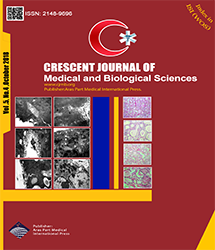
| Original Article | |
| Investigation of Clinical Information System in Gastrointestinal and Liver Diseases Research Centers: Challenges and Solutions | |
| Nahid Ramezan Ghorbani1, Farkhondeh Asadi2, Mehrnaz Hajiabedin Rangraz3 | |
| 1Department of Development and Coordination Scientific Information and Publications, Deputy of Research and Technology, Ministry of Health and Medical Education, Tehran, Iran 2Department of Health Information Technology and Management, School of Allied Medical Sciences, Shahid Beheshti University of Medical Sciences, Tehran, Iran 3Department of Development and Coordination Scientific Information and Publications, Deputy of Research and Technology, Ministry of Health and Medical Education, Tehran, Iran |
|
|
CJMB 2018; 5: 279-284 Viewed : 5878 times Downloaded : 3144 times. Keywords : Clinical iinformation system, Gastrointestinal diseases, Liver diseases, Research centers, Iran |
|
| Full Text(PDF) | Related Articles | |
| Abstract | |
Objectives: Today, medical research centers are recognized as the bases for development of high-quality medical knowledge in societies. In this regard, application of clinical iinformation system (CIS) facilitates the achieving of this goal. This study aimed to investigate the challenges and solutions of CIS in the gastrointestinal and liver diseases (GILD) research centers. Materials and Methods: This descriptive-fundamental research was conducted on gastrointestinal and liver diseases academic research centers of Tehran. Research sample was in line with the community, and the data were collected through interviews and using a questionnaire. In addition, validity and reliability of the questionnaire were confirmed via content validity and test-retest, respectively. Results: The results of the study showed that gastrointestinal and liver diseases research centers contained various service-providing sections, including endoscopy, colonoscopy and liver, gastrointestinal and inflammatory bowel diseases, and cancer and each of which had a separated and independent software with no connections to other software and HIS. Moreover, the software had no warning mechanism to track the patients for referral in due time. This mechanism was important since lack of timely referral of the patients could complicate the treatment process and reduce the general health level of the patients. Conclusions: It seems that the designers of CIS must consider the essential and acceptable standards and frameworks in designing and improving this system. |
Cite By, Google Scholar
PubMed
Online Submission System
 CJMB ENDNOTE ® Style
CJMB ENDNOTE ® Style
 Tutorials
Tutorials
 Publication Charge
Medical and Biological Research Center
About Journal
Publication Charge
Medical and Biological Research Center
About Journal
Aras Part Medical International Press Editor-in-Chief
Arash Khaki
Deputy Editor
Zafer Akan


















